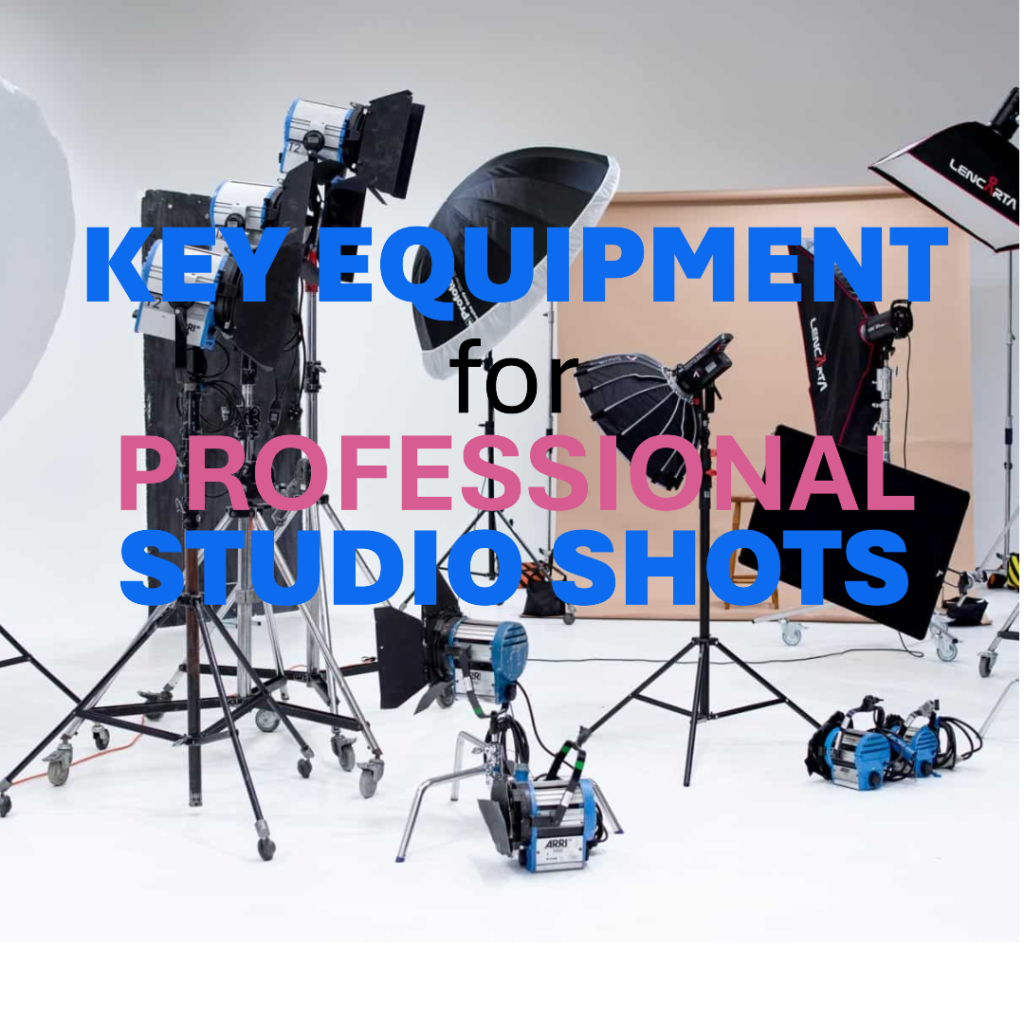Key equipment for professional studio shots includes high-quality cameras, lighting setups, and sturdy tripods. These tools ensure sharp, well-lit, and stable images.
Creating professional studio shots requires a blend of technical skill and the right gear. High-quality cameras capture detailed images, while advanced lighting setups eliminate shadows and highlight subjects effectively. Sturdy tripods stabilize the camera, preventing blurriness. Reflectors and diffusers help manipulate light, enhancing the overall quality of the shot.
Backdrops and props add context and depth, making the photos more engaging. Investing in these essential pieces of equipment can significantly elevate the quality of your studio photography, ensuring that your images stand out in a competitive market. With the right tools, you can consistently produce stunning, professional-grade photos.
Camera Essentials
Professional studio shots require the right camera. It captures every detail perfectly. Choosing the right camera is crucial. Let’s explore the key aspects of camera essentials for studio photography.
Choosing The Right Camera
The first step is selecting a suitable camera. Consider the sensor size. Larger sensors capture more detail. Another factor is megapixel count. Higher megapixels mean sharper images. Look for cameras with interchangeable lenses. They offer more flexibility.
Consider low-light performance. This is important for indoor shoots. Check the camera’s dynamic range. A wider range captures more details in shadows and highlights. Ensure the camera has manual controls. They provide better control over settings.
Recommended Camera Brands
| Brand | Model | Key Features |
|---|---|---|
| Canon | EOS R5 | 45MP, 8K video, Dual Pixel AF |
| Nikon | Z7 II | 45.7MP, 4K video, In-body stabilization |
| Sony | A7R IV | 61MP, Eye AF, 10fps burst |
| Fujifilm | GFX 100 | 102MP, Medium format, Phase detection AF |
These brands offer high-quality cameras. They cater to professional needs. Canon and Nikon are known for their reliability. Sony excels in autofocus technology. Fujifilm provides excellent color reproduction.
Choose a camera that fits your style. Ensure it meets your studio requirements. The right camera enhances your photography skills.
Lens Selection
Lens Selection is a critical aspect of achieving stunning professional studio shots. The right lens can transform a simple setup into a masterpiece. Choosing between prime and zoom lenses, and knowing which specific lenses work best for studio photography, can make all the difference.
Prime Vs Zoom Lenses
Prime lenses have a fixed focal length. They are known for their sharpness and image quality. Prime lenses are often faster, with wider apertures that allow more light. This is beneficial in a studio setting where lighting control is key.
Zoom lenses offer versatility with varying focal lengths. They allow photographers to adjust the composition without moving the camera. Zoom lenses are convenient but can sometimes compromise on image sharpness.
| Prime Lenses | Zoom Lenses |
|---|---|
| Fixed focal length | Variable focal length |
| Sharper images | More versatile |
| Wider apertures | Convenient for framing |
Top Lenses For Studio Photography
Here are some of the top lenses recommended for studio photography:
- Canon EF 50mm f/1.8 STM: Affordable prime lens with excellent sharpness.
- Nikon AF-S NIKKOR 85mm f/1.4G: Ideal for portrait shots with beautiful bokeh.
- Sony FE 24-70mm f/2.8 GM: Versatile zoom lens with superior image quality.
- Fujifilm XF 56mm f/1.2 R: Perfect for detailed close-ups and portraits.
- Sigma 35mm f/1.4 DG HSM Art: Excellent for wide-angle studio shots.
Choosing the right lens can significantly enhance your studio photography. Consider your specific needs and the strengths of each lens.
Lighting Equipment
Lighting equipment is essential for professional studio shots. Good lighting can transform an image, highlighting details and creating mood. Let’s explore the different types of studio lights and the best lighting setups for stunning photos.
Types Of Studio Lights
Various types of studio lights can be used to achieve different effects. Here are the most common ones:
- Continuous Lights: These lights stay on and provide constant illumination. They are great for beginners.
- Strobe Lights: These lights flash to provide a burst of light. They are ideal for freezing action.
- Speedlights: Small, portable lights that attach to your camera. They offer flexibility and convenience.
Choosing the right type of light depends on your needs and the look you want.
Best Lighting Setups
Different lighting setups can create various effects. Here are some of the best setups:
- Three-Point Lighting:
- Key Light: The main light source. It provides the most light.
- Fill Light: This light reduces shadows created by the key light.
- Back Light: This light separates the subject from the background.
- Rembrandt Lighting:
- Key Light: Placed at a 45-degree angle.
- Fill Light: Placed on the opposite side, at a lower power.
- Butterfly Lighting:
- Key Light: Placed directly in front, above the subject.
- Fill Light: Positioned below the subject to fill in shadows.
Using these setups, you can achieve professional studio shots with ease.
Tripods And Supports
For professional studio shots, tripods and supports are crucial. They ensure stability, precision, and flexibility. Whether capturing portraits or products, a good support system is essential.
Choosing A Sturdy Tripod
Choosing the right tripod can elevate your photography. A sturdy tripod ensures your camera remains steady. This is vital for sharp images. Here’s what to look for:
- Material: Carbon fiber tripods are light and strong.
- Height: Select a tripod that suits your eye level.
- Weight Capacity: Ensure it supports your camera and lenses.
- Leg Locks: Quick-release locks save time and effort.
Here’s a table to help you compare tripod materials:
| Material | Weight | Durability |
|---|---|---|
| Aluminum | Moderate | High |
| Carbon Fiber | Light | Very High |
Alternative Support Options
Sometimes, a tripod isn’t the best solution. Here are some alternative support options:
- Monopods: Great for mobility and quick shots.
- Bean Bags: Useful for low-angle shots and uneven surfaces.
- Camera Clamps: Perfect for tight spaces and unique angles.
- Gimbals: Ideal for smooth video shots.
Each support type has its unique benefits. Choose based on your specific needs and shooting style.
Backdrops And Props
Creating stunning studio shots often requires more than just good lighting and a skilled photographer. Two essential elements that can dramatically elevate your photography are backdrops and props. Both of these can add depth, context, and intrigue to your images, making them stand out.
Selecting Backdrops
Your choice of backdrop sets the tone for your entire shoot. Different backdrops can convey various moods and themes. For example, a solid color backdrop can provide a clean and professional look. Patterns can add a creative flair, while textured backdrops can give a more organic feel.
- Solid Colors: Ideal for professional headshots and product photography.
- Patterns: Great for fashion shoots and creative portraits.
- Textures: Perfect for adding depth to still life photos.
When choosing a backdrop, consider the subject and the message you want to convey. Also, ensure the backdrop complements your subject without overpowering it.
Incorporating Props
Props are the unsung heroes of professional studio shots. They can transform an ordinary photo into something extraordinary. Props help to tell a story, set a scene, and enhance the visual appeal.
- Storytelling: Props can give context to the photo.
- Scene Setting: They help in creating a specific environment.
- Visual Appeal: Props add interest and depth to the composition.
When incorporating props, choose items that are relevant to your subject. For instance, a vintage camera can add a nostalgic touch to a portrait. Small, thoughtful props can make a big difference in your final image.
| Backdrop Type | Best For |
|---|---|
| Solid Colors | Professional headshots, product photography |
| Patterns | Fashion shoots, creative portraits |
| Textures | Still life, organic feel |
Modifiers And Reflectors
Modifiers and reflectors are essential tools for creating stunning professional studio shots. They help control light, create mood, and enhance your subject. Understanding their use can elevate your photography skills significantly.
Types Of Light Modifiers
Light modifiers shape and control the light in your studio. They help create different moods and effects. Here are some common types:
- Softboxes: These create soft and even light, reducing harsh shadows.
- Umbrellas: They spread light widely, suitable for larger subjects.
- Beauty Dishes: These produce soft yet focused light, perfect for portraits.
- Grids: They direct light more precisely, adding contrast and drama.
- Gels: These add color to your light, enhancing creativity.
Using Reflectors Effectively
Reflectors bounce light back onto your subject, filling in shadows and adding highlights. They come in various colors and sizes for different effects:
| Type | Effect |
|---|---|
| Silver Reflector | Brightens shadows, adds contrast. |
| Gold Reflector | Warms up the light, adds a golden glow. |
| White Reflector | Softens light, provides a natural fill. |
| Black Reflector | Blocks light, deepens shadows. |
Place the reflector opposite your main light source. Adjust its angle to control the light. Experiment with different colors and sizes to achieve the desired effect.
Studio Accessories
Creating professional studio shots requires more than just a camera and lights. Essential studio accessories play a crucial role in achieving the perfect shot. These tools help you control light, organize your setup, and ensure your subject looks their best.
Essential Tools
Every studio needs certain accessories to function smoothly. Here are some of the most important:
- Light Stands: These hold your lights steady.
- Reflectors: Reflectors bounce light onto your subject.
- Tripods: Tripods keep your camera stable.
- Softboxes: Softboxes diffuse light for softer shadows.
- Backdrops: Backdrops provide a clean background.
Nice-to-have Extras
While not essential, these extras can enhance your studio setup:
- Gels: Gels change the color of your lights.
- Light Meters: Light meters measure the intensity of light.
- Remote Triggers: Remote triggers let you control your camera from a distance.
- Sandbags: Sandbags keep your stands from tipping over.
- Clamps: Clamps hold backdrops and reflectors in place.
| Accessory | Purpose |
|---|---|
| Light Stands | Hold lights steady |
| Reflectors | Bounce light onto subject |
| Tripods | Keep camera stable |
| Softboxes | Diffuse light for softer shadows |
| Backdrops | Provide a clean background |
| Gels | Change color of lights |
| Light Meters | Measure light intensity |
| Remote Triggers | Control camera remotely |
| Sandbags | Stabilize stands |
| Clamps | Hold backdrops and reflectors
|
Conclusion
Mastering professional studio shots requires the right equipment. Invest in quality cameras, lenses, and lighting. Don’t forget sturdy tripods and reliable backdrops. These tools will elevate your photography. Start with essential gear and expand as needed. Achieving stunning studio photos is within your reach with the proper equipment.

